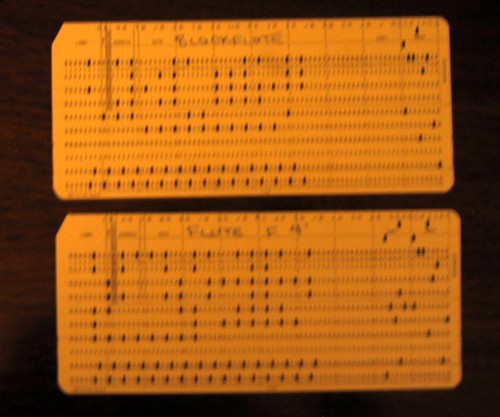Earlier post in this series:
Allen organ project - introduction
It looks as if a necessary first step here is to figure out the format of the data on the cards. Fortunately, the data didn't seem too difficult to reverse engineer.

Here's a bad picture (I'm far too lazy to shoot a better one, since this shows what we need to see) of two of the voice cards. To my ear, both of them sound nearly like sine waves, the Blockflöte at eight-foot pitch and the Flûte at 4-foot pitch.
The first thing I notice is that the large blank area at the middle right of each card is where the reading stops. (The card doesn't go into the reader any farther than that.) So only columns 6-52 (1-5 are blank) appear to be significant for the voice. (The remaining columns are Hollerith-encoded and appear to have a part number for the card and perhaps a few characters of additional information).
The bottom two rows, rows 8-9, of each card appear to have some sort of timing information. (See below - there's more insight to be had here.) On every card, they appear in a regular pattern: 9, 8, space, 9, 8, space.
The only other rows that are punched are 0-6. 7, 11, and 12 are always blank. On the Blockflöte card, you can sort of see a sine wave pattern running in the shape of the punches. This immediately made me guess that row 6 is the most significant bit of a 7-bit binary word. Plotting out the Blockflöte with this assumption gave a graph like:
Looks as if I guessed nearly right, except that this is only half a cycle. Let's see what happens with the flute. Here, row 6 is doing something strange, but I notice that the blank columns above it are moving in a sinusoid? Making the guess that it's two's complement, I plot out the binary numbers there:
Wow, a perfect sine wave!
I'm going to guess from the half-cycle of the 8-foot stop that the electronics in the organ use symmetry to make another half cycle from the samples that are supplied. For the resulting curve to be continuous and smooth, the second half cycle would have to be both inverted in level and reversed in time, so that the complete Blockflöte waveform would be something like:
We'll see whether I'm right if I ever try to make my own voices.
Now what about those timing tracks? I'd have a hard time designing circuitry to clock accurately a card being pushed and pulled by hand - it would be like clocking hand-sent Morse code (a difficult problem!). But wait a minute. Suddenly I remember that when I took a look at the card reader, the lamps seemed slightly
askew. It seemed awfully sloppy construction for a top-of-the-line (for its time) organ like this one. Looking back at the picture, I see:
I can see that rows 11 and 7 are unused, as I expected. Row 12 has a lamp over it; I'm guessing this row is used as an indicator that there's a card in the slot.
Certainly, with that lamp burnt out, no cards are reading, even if they have
no punches in row 12. Row 8 is displaced by about half a column from the others? What will this do to the relative timings? Aha! With the displacement, the row 8 signal will slightly overlap the row 9 one, giving a quadrature encoding that should be completely self clocking! Clever fellows, those Allen engineers. I'll have to remember that when I start blinking LEDs at the thing. I also make an educated guess that the reader is designed to operate on the pull, rather than the push. It's nearly impossible to push the card in evenly, but it's easy to pull smoothly.



No comments:
Post a Comment